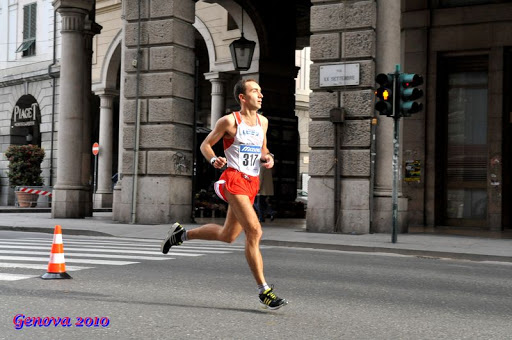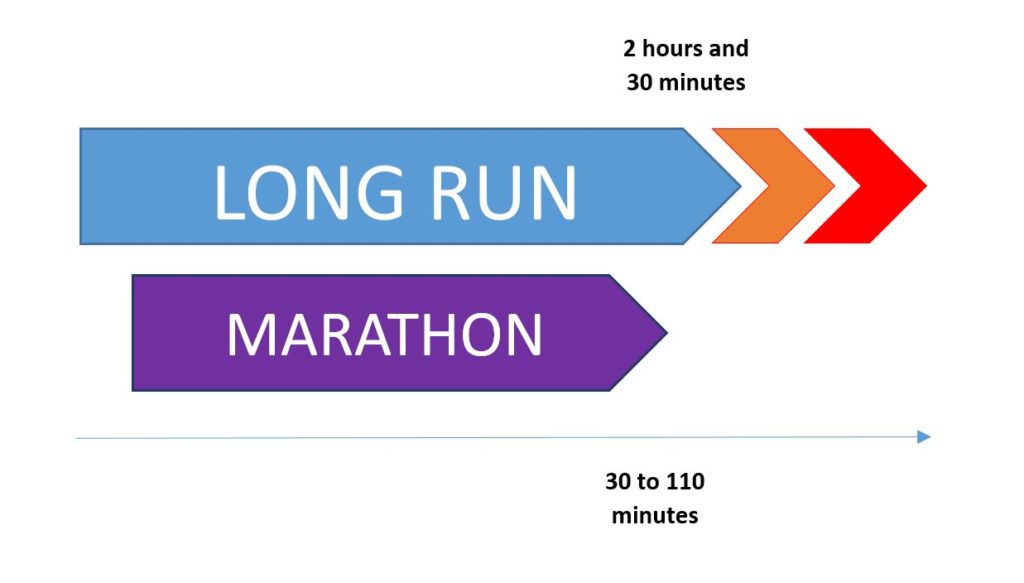Different running paces:
Runners have different pace available. The Marathon pace is the second pace used during our running training. It is difficult to define precisely the Marathon pace. For a training session, it does not matter if you run five seconds too fast or too slow. However, during a Marathon race, it can be a disaster and finish with many minutes lost at the finish line.
The marathon pace for top athletes who are running between 2 hours and 2 hours 30 minutes is completely different physiologically to a runner closing the marathon in 5 hours.
There are five different paces available and should be used in the different phases of the training plans:
1 – Endurance pace / Easy pace
2 – Marathon pace
3 – Threshold pace
4 – Interval pace
5 – Repetition pace
Further to these general pace, sprinters should work at faster pace, but they are very specific and linked to the different sprinting distances (100m, 200m and 400m).
Marathon pace:
The marathon pace is slightly faster than the Easy pace. At marathon pace, the heart rate will go higher, but keeping a conversation should be not an issue.
We will not complete a training session totally at this pace. The marathon pace is used mainly during the long runs, and in the last four weeks before a marathon to ensure the runner know this pace very well even without checking the watch.

Another important point is to train all technical aspects that are happening during the race. It is important to test it every weeks during the training sessions to avoid a surprise during the race. Some of the technical points that should be tested at this speed are:
– Pick up a bottle or a cup from an aid station at this speed,
– Drink from the bottle or the cup,
– Pick up a gel from your pocket, belt or other gel holder,
– Open the gel with sweaty hands,
– Eat the gel or food of your choice,
– Put on or remove your jacket, sun glasses…
All of these actions seems easy, but after few hours of running, with wet hands and less lucidity, it can be very challenging. It is not uncommon to watch top athlete miss their water bottle at the aid station.
And as we say during a marathon, never miss an aid station!
The benefits of the Marathon pace is to challenge the body by increasing the heart rate, concentrating on the form to avoid spending too much energy. Last, it is important to learn this specific pace in order to be able to run at this exact pace without looking at your watch.
Runners can use this endurance pace for few hours to complete the marathon distance.
The pace:
The Marathon pace is roughly running at eighty five percent of your maximal heart rate. Using the general table, it depend of your age:
| Age | Maximal Heart rate (Max HR = 220 – age) | Endurance pace (~ 85% max HR) |
| 20 years | 200 bpm | 170 bpm |
| 40 years | 180 bpm | 153 bpm |
| 60 years | 160 bpm | 136 bpm |
| 80 years | 140 bpm | 119 bpm |
This general table is not fitting all of us. Depending of your fitness and the history of your training, your maximal heart rate may be different. You can go to a sport doctor to perform a stress test on a stationary bike or a treadmill to define your own maximal heart rate.
Untrained people will have their easy pace at 75% of their maximal heart rate and top athletes can even push up to nearly 90% of their maximal heart rate.
Another important point to define the marathon pace, is to understand that running a marathon in less than three hours will require just a small amount of carbohydrate intake during the race. However, running during five hours will require to drink and eat more. Then, more blood will be needed at the level of the stomach and gastric system to integrate these calories.
Another way to estimate your Marathon pace is to define it with your current racing result. Extrapolating the marathon pace from a 5km is not very accurate. I prefer to use results of a half marathon run just four to six weeks before the marathon:
| Half Marathon time | Marathon pace [/kilometers] | Marathon pace [/miles] |
| 75 minutes | 3’45”/km | 6’/mile |
| 90 minutes | 4’30”/km | 7’15”/mile |
| 105 minutes | 5’10”/km | 8’20”/mile |
| 120 minutes | 6’/km | 9’40”/mile |
It is a good estimate, but to be more precise discuss directly with your coach.
The duration:
The long run should integrate parts run at Marathon pace. The duration should last twenty minutes at minimum. The beginning of the session should include a good warm-up, then few miles at Easy pace before increasing the pace to Marathon pace. Then the pace should slow down again to an Easy pace and conclude with a cool-down. With the increase of the long run duration, the part of the marathon part should increase too.
For most of the runners, the longest session should be two hours and thirty minutes. However, only part of this session should be at marathon pace. I suggest keeping the maximum duration of the marathon pace to hundred and ten minutes. It will take beginners months before being able to run such a duration. These long runs should be built gradually and will need few days to recover. You will burn a lot of calories (carbs and fat) and as well lose a lot of water and minerals with the sudation. It is important to re-integrate well after the long runs.

Example of session:
Usually the long runs are getting longer every week, and the portion of the long run at marathon pace need to increase progressively too. Here is an example of the progression:
– 90 minutes, 20 minutes at marathon pace
– 110 minutes, 30 minutes at marathon pace
– 130 minutes, 2 x 20 minutes at marathon pace
– 150 minutes, 40 minutes + 20 minutes at marathon pace
For advanced athletes it can be :
– Long run 150 minutes, 110 minutes at marathon pace
Conclusion:
The marathon pace is very similar to the Endurance pace. It is a little more challenging but the heart rate need to stay at roughly 85% of your maximum.
This pace is used mainly by marathon runners, but I like to include this pace in many training plans especially in the long run. The long run must not be fully at marathon pace, but will support a faster pace than the usual Endurance pace.
For runners training for a marathon, it is important to train to refuel (drinks, food) at this exact pace the weeks and months before the marathon. Drinking from a cup at marathon pace is always challenging.
Meet your team mate on your long runs, and try to keep a controlled Marathon pace during the runs. The pace need to be automatic before your next marathon, and you should not use your GPS watch to control this specific speed. It is more challenging than Endurance or Easy pace but you should still be able to chat with your friends.
